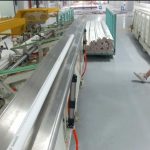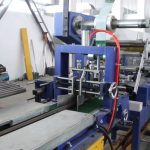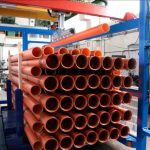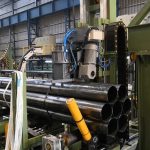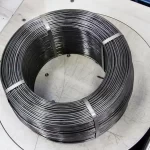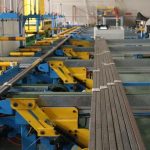How Does an Automatic PVC Pipe Packing Machine with Bundling and Bagging Streamline Production?
I often see companies fall behind schedule when they rely on manual pipe packing. That creates chaos for shipping departments and frustrates customers who expect timely deliveries.
A powerful automatic system solves these problems. It bundles and bags PVC pipes at a steady pace, reduces human errors, and frees operators to focus on higher-level tasks. It keeps packaging waste in check, speeds output, and enforces consistent wrapping standards.
I want to share the key factors that make this system a valuable upgrade. My experiences at FHOPEPACK show me how a smooth packaging line can save labor, raise product protection, and lead to happier clients. Please read on if you want to see how an automated solution transforms daily operations.
What Core Features Drive Efficiency and Consistency in Pipe Packaging?
Manual wrapping often creates mistakes that cost time. That includes uneven bundling or loose bag seals. That leads to potential product damage or shipping delays.
Automatic packing machines enforce uniformity from start to finish. They measure pipe lengths, apply the correct tension, and seal bags precisely. This ensures each bundle meets consistent quality standards.
I see how these machines include programmable parameters, robust sensors, and heavy-duty frames. They unify speed, accuracy, and user-friendly design, giving manufacturers reliable performance without constant operator intervention.
Increasing Throughput and Reducing Variation
I remember the first time I switched from manual to automated packing. I noticed immediate improvements in cycle times. The machine aligned PVC pipes, guided them into bundles, and sealed them with minimal rework. By removing guesswork, the entire line sped up. That higher speed also kept packaging quality stable. Each bundle received the same level of tension and wrap coverage.
The Role of Automated Sizing and Sorting
PVC pipes can vary in diameter or length. Some packaging lines struggle with random loads. An advanced machine uses sensors or scanning systems to identify pipe dimensions. It adjusts feed mechanisms and bagging lengths in real time. This means the operator does not have to stop production to recalibrate for a new pipe size. This flexible response saves time on each shift.
Consistent Tension for Each Bundle
I have seen how tension matters for holding multiple pipes together. If it is too tight, the plastic can deform or crack. If it is too loose, the pipes shift in transit. Automated bundling equipment uses servo drives or pneumatic controls to apply a set tension level every time. An operator can input the tension range for each product type. The machine enforces that setting. This approach eliminates manual over-pulling or under-securing, which used to happen in older lines.
Precise Bagging Mechanism
A packaging line must keep each bundle sealed to protect it from dust or moisture. An automatic system measures the proper bag length and uses heat sealing or mechanical sealing at the right spot. That saves material compared to manual methods, where workers might overestimate bag length to avoid short coverage. Over time, consistent bag sizing reduces waste and cuts film costs. It also prevents open edges or partial coverage.
Monitoring Tools and Data Collection
Some machines log how many bundles they process each hour, how much film remains on each roll, or if a sensor detects misalignment. Operators see this data on a control panel. If something goes wrong, the machine can pause to prevent further damage. This real-time feedback helps staff identify problems early, so they fix them right away instead of letting errors pile up. When they spot a trend, like frequent misfeeds, they can examine the feed mechanism or consider alternative film materials.
Frame Durability and Easy Maintenance
PVC pipe packaging requires handling heavier loads when large bundles form. Weak frames vibrate or shift over time, which leads to misalignment or part failures. A well-built machine uses thick steel or rigid construction to anchor moving parts. Maintenance is simpler when the system has wide openings or removable panels. That means workers can clean or check belts without dismantling the entire line. Durable hardware, combined with easily accessible parts, lowers downtime and raises machine availability.
| Core Feature | Action or Benefit | Outcome |
|---|---|---|
| Automated Sizing | Detects pipe dimensions in real time | Faster, more flexible changeovers |
| Controlled Tension | Applies uniform bundling force | Consistent, damage-free bundles |
| Precision Bagging | Accurately seals bags to exact lengths | Minimal film waste, secure coverage |
| Real-Time Monitoring | Logs production data and alerts operators | Swift error correction |
| Strong Frame Design | Keeps machine stable under load | Less vibration, easier maintenance |
Reducing Labor Requirements
Manual processes often require multiple operators to bundle, tape, or bag pipes. When you switch to an automated system, you free up staff to handle more valuable tasks, such as final quality checks or shipping logistics. I have seen one operator supervise multiple stations after upgrading. That shift usually lowers labor expenses and boosts output. In addition, skilled workers prefer tasks that require problem-solving instead of repetitive motions. That can lead to higher job satisfaction.
The Bottom Line
All these features work together to promote a streamlined, consistent pipeline. You get the benefits of speed, reduced errors, and better product protection. Clients receive their orders in good condition, which increases trust and repeat business. In my view, these core features mark the difference between basic mechanization and a truly optimized packaging operation.
How Do Bundling and Bagging Systems Enhance Workplace Safety and Output?
I have walked through busy plants where loose pipes clutter floors, raising trip hazards. Manually lifting heavy bundles also strains employees physically.
Automated bundling and bagging systems solve these issues. They guide pipes along conveyors, minimize manual lifts, and package them in neat, sealed units. That keeps floors clear and reduces the chance of injuries.
I see that when a facility reduces these risks, productivity rises. Operators gain confidence in the machines and stick to deadlines more easily. Organized packaging lines lead to smooth scheduling and fewer workflow interruptions.
Protecting Workers While Boosting Production
Before I encountered advanced bundling equipment, I saw many cases of back or shoulder strains from hefting awkward loads of pipes. When a machine takes on these tasks, staff can focus on maintenance checks or final inspections. This shift improves morale, lowers downtime, and meets safety regulations more consistently.
Automated Conveyors Reduce Manual Handling
A bundling and bagging line often starts with conveyors that feed PVC pipes in a single row or in groups. Operators do not have to bend or lift as often. They position pipes at the start, then let the machine do the rest. If your company deals with large-diameter pipes, you know they can get heavy. Shifting that workload to conveyors prevents typical musculoskeletal complaints. The machine can also align pipes automatically, so employees do not push or rotate them by hand.
Better Organization and Less Clutter
When the process is manual, half-finished bundles or loose pipes accumulate on the floor. That creates obstacles and potential accidents. Automated systems keep items flowing from one stage to the next. They do not let partially bundled pipes sit around. The line merges bundling with bagging in a single pass, so the final product quickly moves onto the next station or into storage. This approach frees space, which helps forklift movement and lowers the chance of collisions.
Reduced Risk of Strain Injuries
Operators who repeatedly lift pipe bundles risk chronic pain. Over time, that leads to higher worker turnover, insurance claims, and production disruptions. A mechanized line transitions physical lifts to automated arms or conveyors. Staff who used to handle pipes can now manage the controls or oversee multiple lines. This shift from repetitive lifting to monitoring a machine lowers injury rates. I have watched how a stable workforce emerges when people stop quitting due to injuries or exhaustion.
Consistent Output Without Overexertion
Manual bundling often slows down during busy shifts, because workers get tired. Automated bagging lines maintain a steady pace. They do not tire. They do not vary speed based on how many hours someone has worked. That consistent output helps production planners maintain schedule. If a facility must handle multiple packaging shifts, the machine can keep running with only minimal operator oversight. It is easier to forecast daily or weekly throughput when the line does not depend on worker stamina.
| Safety and Output Factor | Mechanized Benefit | Impact on Operations |
|---|---|---|
| Conveyor Feeding | Minimizes manual pipe transfers | Fewer injuries, smoother workflow |
| Single-Pass Packaging | Merges bundling and bagging in one flow | Less floor clutter, faster shipping |
| Controlled Movement | Eliminates repetitive lifts and shifts | Reduced worker fatigue and turnover |
| Steady Production Speed | Maintains cycle time regardless of shift | Predictable output, simpler planning |
| Lower Injury Rates | Cuts common strain-related problems | More stable workforce, fewer claims |
Automation as a Driver of Growth
When staff do not risk injuries, morale climbs. People become more open to learning new skills, like machine programming or advanced quality checks. Companies can diversify their production lines without worrying about overworking the team. That environment fosters growth, because the business invests in equipment that sustains high output, not just in temporary labor solutions. The result is a more resilient operation that can handle seasonal spikes or new product lines.
Meeting Compliance and Standards
Many regions have workplace safety regulations that limit how heavy or how often employees can lift. Automated bundling lines help meet these rules. They also keep consistent records of each bundle. Some advanced systems log bundle sizes, number of pipes per bundle, or bagging data. That documentation can help with audits or prove compliance with shipping standards. If a regulator asks for evidence that workers are not pushing the lifting limit, the presence of an automated system is strong proof.
Efficiency Gains That Compound Over Time
Every day you run an automated bundling line, you save a little on labor and reduce a bit of risk. Over a year, that adds up. Fewer injuries mean fewer lost workdays. Consistent packaging means you do not rework or discard damaged pipes. Workers direct their attention to tasks that require judgment, which the machine cannot handle. That synergy of labor and automation leads to more stable performance. It also improves relationships with customers who count on well-bundled, properly bagged PVC pipes arriving on time.
For me, the biggest lesson is that safety and output are linked. If workers feel stressed or overloaded, mistakes happen, or accidents occur. The automatic bundling line eliminates those hazards, so operators trust the system. They become more engaged with improving processes. That dynamic drives continuous improvements, leading to faster packaging cycles and fewer returns.
What Should You Consider When Choosing the Right Machine Configuration?
I have seen companies rush to buy the biggest, fastest system, only to discover they lack floor space or operator training. It is crucial to align your real production goals with machine specifications.
You should analyze pipe dimensions, packaging speed, available layout, and maintenance needs. A well-chosen machine that matches these variables avoids costly downtime and wasted capital.
I believe it is also vital to consider integration options. Does the machine link to existing conveyors or sorting stations? Does it allow for future expansions or modifications? A flexible design prevents expensive reconfigurations down the road.
Building a Path to Long-Term Success
Some of my most rewarding projects involved setting up a packaging line that could scale with a company’s growth. We looked at daily output, future expansion plans, and how new staff would operate the machine. By taking time to think about these details, we avoided major stumbling blocks later. The right configuration stands as a key driver of sustainable efficiency and reliability.
1. Assessing Production Volume and Speed Requirements
Start with an estimate of how many PVC pipes you handle each hour or day. Then factor in peak periods. Some lines run steadily all year, while others spike with seasonal demand. Match the machine’s cycle time to your highest output needs. If you choose a system that barely meets peak demand, you may stress the equipment or staff. On the other hand, an oversized machine might waste resources if your volume is moderate. Aim for a balanced approach that can handle small bursts without large idle periods.
2. Pipe Dimensions and Bundle Size
PVC pipes vary in diameter, wall thickness, and length. Check the specs for each product type you bundle. Ensure the machine can handle your largest pipe diameter and the smallest one. Some machines only accept a certain range. Also, confirm how many pipes form a standard bundle. If your clients prefer bundles of ten pipes, the bundling arms must hold that many securely. If you plan to produce both small retail bundles and large wholesale bundles, you may need adjustable tension settings or separate output lanes.
3. Layout Constraints and Safety Zones
Measure your available floor space carefully. Automated lines often include entry conveyors, bundling stations, bagging modules, and exit conveyors. You also need room around the machine for maintenance or operator movement. Some sites have columns, low ceilings, or narrow aisles that complicate equipment placement. Visualize how forklifts or carts approach the machine. You want a clear path for raw pipes in and wrapped bundles out. Avoid forcing staff to cross busy forklift lanes to reach the control panel.
4. Integration with Existing Systems
Do you already have an upstream sorting system that arranges pipes by length? Or do you plan to add a robotic palletizer downstream? A well-configured machine ties in with these systems so the entire flow remains smooth. Look for flexible interfaces or standardized protocols that let the new equipment communicate with older machines. I have seen packaging lines jam when the upstream feeder moves faster than the bundling station. A mismatch in speeds or signals can cause backups or collisions.
5. Maintenance and Operator Training
Even the best machine needs routine service. Check how easy it is to access internal parts. Ask about spare part availability and lead times. Does the supplier offer local support or remote troubleshooting? Operator training is also critical. I once saw a brand-new line sit idle because operators found the interface confusing. A day or two of thorough training would have saved that headache. Make sure you have a plan for staff turnover. The knowledge to run or maintain the machine should not vanish when a single operator leaves.
6. Flexibility for Future Growth
PVC production can shift based on new contracts or design changes. If you anticipate new pipe sizes or an increase in demand, look for a modular machine. Modular design means you can add stations, like an extra bundling unit or an extended conveyor, without uprooting the entire line. Some systems also allow software upgrades that unlock advanced features. Plan for expansion at the outset. It may cost more initially, but it often saves major headaches and costs a few years down the line.
7. Energy and Consumables
Automated machinery runs on power, compressed air, or both. Check if your facility has the right utilities. For example, a high-capacity air compressor might be needed for certain pneumatic bundling heads. Also, consider how often you will change film or straps. If you run a large volume, it is wise to keep spares and have a quick way to swap out rolls. The time operators spend refilling consumables can add up if you have not accounted for it.
| Consideration | Why It Matters | Possible Approach |
|---|---|---|
| Production Volume | Matches machine speed to peak demand | Aim for capacity slightly above normal load |
| Pipe Size and Bundles | Ensures machine can handle your full product range | Check diameter, length, and bundle counts |
| Layout and Safety | Prevents cramped spaces and collisions | Map conveyor paths and operator walkways |
| Integration Level | Syncs with existing or planned equipment | Check for standardized interfaces |
| Maintenance Approach | Lowers downtime and parts shortages | Ensure local support or remote service |
| Future Flexibility | Makes expansions simpler and cheaper | Consider modular design and software upgrades |
| Utility Needs | Prevents power or air supply issues | Verify facility specs and plan consumables |
8. Return on Investment
Think about the machine’s cost and the savings in labor, reduced damage, or increased throughput. An automatic bundling line can pay for itself in labor reductions alone if you currently rely on multiple operators. Also, factor in intangible benefits like safer workplaces, happier staff, and consistent product presentation. Clients often prefer suppliers who deliver uniform packaging. That can lead to repeat business. A costlier machine may have better sensors and higher speed. If that yields better uptime and output, the payback may be quicker than a cheaper system that breaks often.
9. Testing and Trials
Some suppliers allow sample runs with your actual pipes. They show how the machine handles different diameters or lengths. Observing a trial can confirm tension settings, bag sizes, or feed rates. It also helps operators see how the controls work. If an on-site test is not possible, watch demonstration videos or request references from users with similar pipe products. This step builds confidence in your choice before you finalize the purchase.
When you address these considerations, you reduce the risk of over- or under-buying. You also set a strong foundation for stable daily operations. In my experience, thinking ahead at the design stage stops many problems. A well-configured bundling and bagging system runs for years with minimal hiccups, leaving you to focus on improving other parts of your facility.
Conclusion
I have seen how an automatic PVC pipe packing machine with bundling and bagging transforms production lines. It reduces manual labor, ensures consistent coverage, and cuts the chance of pipe damage. It also makes the workplace safer by removing heavy lifts and cluttered aisles. In my time at FHOPEPACK, I realized that picking the right machine depends on a clear understanding of volume, pipe variety, floor layout, and maintenance goals. That preparation leads to a stable, cost-effective solution that supports ongoing growth. An advanced bundling system is more than a piece of hardware. It is a strategic asset for any operation that values high-speed output, reliable protection, and a healthier, more efficient workforce.
